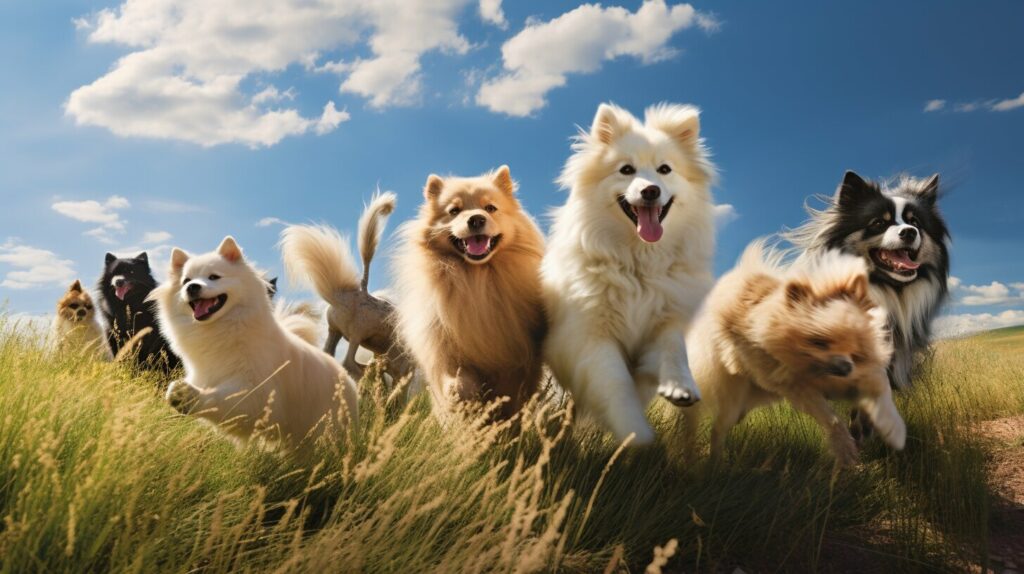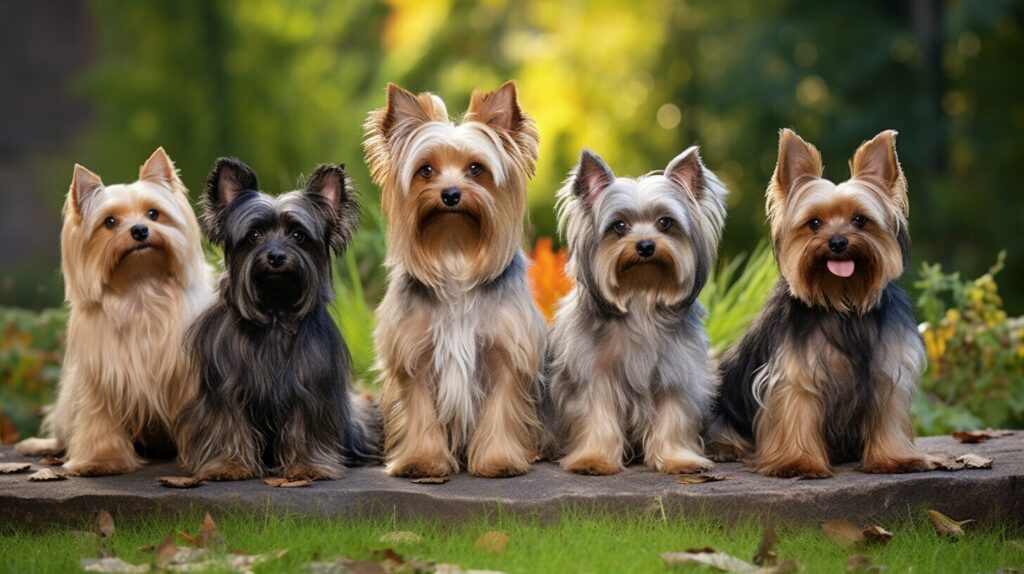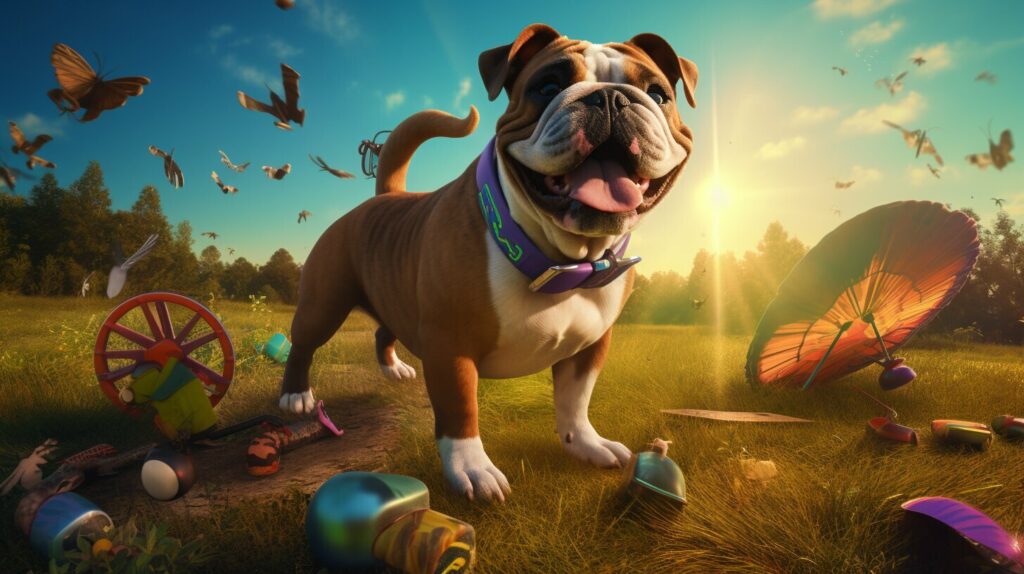If you’re looking for a loyal and affectionate furry friend, you might want to consider Spitz dogs. These breeds have a rich history and unique characteristics that make them stand out from the crowd. From their thick double coats to their pointed ears and curly tails, Spitz dogs are simply adorable. But they’re not just a pretty face. They’re also known for their intelligence, independence, and loyalty.
In this article, we’ll explore the world of Spitz dogs and help you decide if they’re the right pets for you. We’ll discuss their history, temperament, grooming needs, and health concerns. By the end of this article, you’ll have a clear understanding of what it takes to care for a Spitz dog and what benefits they can bring to your life.
Key Takeaways
- Spitz dogs have distinct physical characteristics, including thick double coats, pointed ears, and curly tails.
- These breeds are known for their intelligence, independence, and loyalty, making them great family pets.
- Spitz dogs require regular grooming and exercise, as well as a suitable living environment.
- Maintaining their overall health and well-being involves proper nutrition, exercise, and regular vet check-ups.
The History of Spitz Dog Breeds
Spitz dogs are a group of breeds with a shared ancestry that dates back thousands of years. They originated in Arctic regions and were bred to be working dogs, assisting with tasks such as hunting, herding, and pulling sleds.
The exact origins of Spitz breeds are not known, but many believe they are descended from dogs that existed during the Neolithic period. It is widely believed that Spitz breeds were brought to other parts of the world by early explorers and traders, where they were adapted and developed into new breeds.
One of the earliest Spitz breeds is the Samoyed, which is believed to have originated in Siberia. These dogs were used by the Samoyed people for hunting and herding, as well as for keeping their owners warm during the long, cold winters. The Samoyed is still a popular breed today, known for its fluffy white coat and friendly personality.
Another well-known Spitz breed is the Pomeranian, which originated in what is now Poland and Germany. Originally larger and used for herding, Pomeranians were later bred down in size to become the lapdogs we know and love today.
The Japanese Spitz is a more modern Spitz breed, developed in the 20th century from a mix of other Spitz breeds such as the Samoyed and the German Spitz. They were bred to be companion dogs and are known for their loving and playful nature.
Overall, Spitz breeds have a rich history that spans thousands of years and many different regions of the world. From their origins as working dogs in the Arctic to their roles as beloved family pets today, Spitz breeds have played an important part in human history and continue to bring joy and companionship to many households.
Understanding Spitz Characteristics
Spitz dogs are known for their distinctive physical features and other traits that set them apart from other breeds. Some of the most notable Spitz characteristics include:
| Physical Appearance | Distinctive Traits |
|---|---|
| Thick double coat | Strong prey drive |
| Pointed ears and muzzle | Curling tail |
| Medium to large size | Independent nature |
Spitz dogs also come in a variety of coat types, including thick and fluffy coats on breeds like the Samoyed and Akita, and shorter, smoother coats on breeds like the Shiba Inu. They also have a range of colors, from white and cream to black and brown shades.
Another unique characteristic of Spitz breeds is their vocalization. They are prone to howling, yodeling, and barking, which can be a challenge for owners living in close quarters with neighbors.
Overall, Spitz dogs are highly intelligent, active, and loyal companions. They are known for their endurance and were originally bred for working purposes, such as hunting, sledding, and herding, making them a great choice for owners who enjoy outdoor activities with their furry friend.
If you are considering getting a Spitz dog, understanding their unique characteristics can help you choose the right breed for your lifestyle and provide them with the proper care and training they need to thrive.
Creating the Perfect Environment for a Spitz Dog
If you’re considering adding a Spitz dog to your family, it’s important to create the ideal environment for them to thrive. Spitz dogs are known for their energetic and active personalities, so providing plenty of exercise opportunities is a must.
Choosing the Right Spitz Dog for Your Lifestyle
Before bringing a Spitz dog home, it’s important to consider your lifestyle and how it aligns with your potential new furry companion. Some Spitz breeds, like the Siberian Husky and Alaskan Malamute, have high exercise needs and require plenty of outdoor space to run around. On the other hand, smaller Spitz breeds like the Pomeranian and the Japanese Spitz are better suited to apartment living and less strenuous exercise.
Ideal Environment for Spitz Dogs
Regardless of the Spitz breed, all these dogs thrive in environments with plenty of exercise opportunities, mental stimulation, and socialization. A backyard or access to a park for outdoor playtime is a great start, but daily walks or runs are also necessary to release their energy. In addition to physical exercise, Spitz dogs also benefit from mental challenges such as puzzle toys or interactive games.
Space Requirements
When it comes to indoor living space, Spitz dogs generally don’t require a lot of room as long as they have plenty of opportunities for exercise and mental stimulation. However, they do need a comfortable and cozy area to relax and rest. Consider providing a comfortable dog bed or crate for your Spitz dog to rest in when they’re not playing or exercising.
Overall, creating the ideal environment for a Spitz dog involves plenty of exercise, mental stimulation, a comfortable resting area, and consideration of the specific breed’s needs. With the right environment and care, a Spitz dog can be a loving and loyal companion for years to come.
Grooming Tips for Spitz Dogs
Spitz dogs are known for their beautiful thick fur which protects them in cold climates. However, their fur requires regular grooming to maintain its luster and avoid matting. Here are some essential grooming tips to keep your Spitz dog healthy and happy:
Brushing Techniques
Brush your Spitz dog’s coat at least once a week, or more frequently during shedding season. Use a pin brush to remove tangles and mats from the undercoat, followed by a slicker brush to remove loose fur and keep the topcoat shiny. Be gentle when brushing as Spitz dogs have sensitive skin.
Bathing Recommendations
Bathe your Spitz dog every 6 to 8 weeks or as needed. Use a mild dog shampoo and conditioner to avoid stripping natural oils from their fur. Use lukewarm water and rinse thoroughly to avoid leaving any shampoo residue. Dry them off with a towel or a hairdryer on the lowest setting, being careful not to overheat their skin.
Special Care for Double Coats
Spitz dogs have a double coat consisting of a soft undercoat and a longer, coarser topcoat. Their undercoat sheds heavily during spring and fall, so extra care is needed during these seasons. Use an undercoat rake to remove loose fur and prevent matting. Generally, Spitz dogs do not require trimming, except for occasional trimming of their paws and sanitary areas.
Follow these grooming tips to keep your Spitz dog looking healthy and beautiful. With proper care, your Spitz dog’s fur will be a source of pride for both of you.
Unraveling the Spitz Temperament
Spitz dogs are known for their unique temperament that sets them apart from other breeds. Their intelligence, independence, and loyalty make them excellent companions, but it’s essential to understand their personality traits to provide the best care.
Intelligent: Spitz dogs are highly intelligent and love to learn. They respond well to positive reinforcement, so training them using treats and praise is highly effective. Keep them mentally stimulated by providing interactive toys and games that challenge their intelligence.
Independent: Spitz dogs have a strong independent streak. They were bred to work alongside humans, but they also have an innate sense of adventure that makes them enjoy exploring on their own. This trait can make them challenging to train and may require extra patience and consistency.
Loyal: Spitz dogs are fiercely loyal to their owners and make excellent guard dogs. They tend to bond closely with one or two family members and can become protective of them. Socialization is crucial to prevent them from becoming overly protective and aggressive towards strangers.
Interaction with Children and Other Pets: Spitz dogs can be great family pets, but they require early socialization with children and other pets to prevent them from becoming too dominant. Teach children to respect their boundaries and avoid rough play with them. Spitz dogs may see smaller pets as prey, so early socialization is crucial to get them used to other animals.
Effective Training for Spitz Dogs
If you’re considering adding a Spitz dog to your family, it’s important to understand that training these independent pups can require patience and persistence.
Positive reinforcement methods, such as praise and treats, work best for Spitz dogs. They respond well to good behavior, so be sure to reward them immediately for their efforts. Consistency is also key; try to establish a routine and stick to it.
Socialization is crucial for Spitz dogs to develop good behavior around other people and pets. Introduce them to different environments and situations gradually, always supervising their interactions.
Keep in mind that Spitz dogs can be strong-willed, and addressing any potential challenges unique to their breed may require additional effort. Consider enlisting the help of a professional dog trainer if needed.
Remember that training is an ongoing process, especially with Spitz dogs. Regular reinforcement of good behavior and continued socialization will help your furry companion become a well-behaved member of your family.
Ensuring Spitz Dog Health and Well-being
If you’re considering getting a Spitz dog, it’s essential to ensure their overall health and well-being. Here are some tips to keep in mind:
Regular Vet Check-Ups
Just like any other dog breed, Spitz dogs need regular visits to the vet to maintain their health. Be sure to schedule routine check-ups, and don’t hesitate to take your Spitz dog to the vet if you notice any unusual changes in their behavior or health.
Nutrition
Spitz dogs have unique dietary requirements, and it’s essential to feed them a well-balanced diet to keep them healthy. Consider consulting with your vet to determine the best nutritional plan for your Spitz dog and avoid feeding them table scraps and other human foods that could be harmful to their health.
Exercise
Spitz dogs are energetic and require regular exercise to stay healthy and happy. Be sure to provide them with enough physical activity, such as daily walks or runs, to keep them mentally and physically stimulated.
Preventive Care Measures
There are several preventive care measures you can take to maintain your Spitz dog’s overall health and well-being, such as regular grooming and dental care. Be sure to brush their coat regularly, trim their nails, and keep their teeth clean to avoid potential health problems down the line.
Ensuring the health and well-being of your Spitz dog requires dedication and effort, but it’s all worth it for a happy and healthy companion. By following these guidelines and working with your vet, you can provide your Spitz dog with the care and attention they need to thrive.
Conclusion
Congratulations! You’ve learned about the unique characteristics of Spitz dogs and why they make such wonderful companions. Whether you’re looking for a working dog, a family pet, or a loyal friend, a Spitz dog could be the perfect match for you and your lifestyle.
Remember to consider the ideal living conditions and grooming needs of a Spitz dog before making your decision. With a little patience and effort, you can create a perfect environment for your furry friend and keep them healthy and happy for years to come.
Consider Adding a Spitz Dog to Your Family Today
If you’re ready to experience the joy of owning a Spitz dog, take some time to research different breeds and find the one that fits your lifestyle the best. With their intelligence, independence, and loyalty, Spitz dogs can bring years of happiness and companionship to your life.
Thank you for taking the time to learn about Spitz dogs. We hope this guide has been helpful in your search for the perfect furry friend. Best of luck on your journey to find your next companion.
FAQ
Q: What are the different breeds of Spitz dogs?
A: Some popular breeds of Spitz dogs include the Samoyed, German Spitz, American Eskimo Dog, Akita, Alaskan Malamute, and Shiba Inu.
Q: Are Spitz dogs good with children?
A: Spitz dogs can be great with children when properly socialized and trained. However, it’s important to supervise interactions and teach children how to approach and handle dogs respectfully.
Q: How much exercise do Spitz dogs need?
A: Spitz dogs are active breeds and require a good amount of exercise to stay happy and healthy. Daily walks, playtime, and mental stimulation are important for meeting their exercise needs.
Q: Do Spitz dogs shed a lot?
A: Yes, most Spitz dogs have a thick double coat and shed seasonally. Regular grooming and brushing can help manage shedding and keep their coat in good condition.
Q: Can Spitz dogs live in apartments?
A: While some Spitz breeds can adapt to apartment living, they generally require a fair amount of exercise and space to roam. It’s important to provide regular exercise and mental stimulation for Spitz dogs in apartments.
Q: Are Spitz dogs easy to train?
A: Spitz dogs are intelligent but can have a stubborn streak. Positive reinforcement training methods and consistent, patient training can yield good results with Spitz breeds.
Q: What are common health issues in Spitz dogs?
A: Some common health concerns in Spitz dogs include hip dysplasia, eye issues, allergies, and certain genetic conditions. Regular vet check-ups and a proper diet can help maintain their overall health.
Q: How long do Spitz dogs typically live?
A: Spitz dogs generally have a lifespan of 10 to 14 years, depending on the breed and individual health factors.



